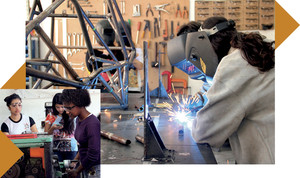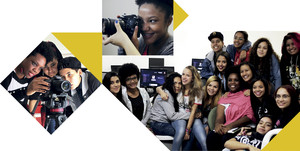
FUNDO ELAS | ROBERTO RIBEIRO
Students build a car for the competition at the Federal University of São João del Rei in Minas GeraisFUNDO ELAS | ROBERTO RIBEIROLast year, Bárbara Gomes, a student in her final year of production engineering at the Federal University of São João del Rei (UFSJ) in Minas Gerais, along with her classmates created the Women in Engineering project, which involved more than 100 students from a state high school in that same city in building a prototype car to compete in Formula SAE, a competition for electric vehicles developed by undergraduate students and promoted by the Mobility Engineers Society (SAE). “When I was a child, I didn’t like dolls very much and I was always interested in math. My choice of engineering was inevitable,” says Gomes. At age 23, she is convinced that the low numbers of women in scientific and technological careers are the result of a lack of stimuli, starting as early as elementary school. “We grew up hearing that stereotype that girls are not good at logical thinking,” she says.
The initiative at São João del Rei was one of several programs included in the call for projects titled Elas nas Exatas (Females in the Exact Sciences), which was launched in 2015 by the Unibanco Institute, the ELAS Fund, and the Carlos Chagas Foundation to finance initiatives that reduce the impact of gender inequality in students’ career choices. The ten projects selected from the more than 170 entries each received R$30,000 and have already been completed.
The proposals were submitted by women’s groups, feminist collectives, research groups, parent and teacher associations, and other organizations in partnership with public high schools. One of the requirements of the venture was that the projects involve the school community. “In public education, there is a huge difference between boys and girls when it comes to the exact sciences,” says political scientist Kelly Kotlinski Verdade, also known as K. K. Verdade, executive coordinator of the ELAS Fund; this fund receives support from companies like Chevron and from foundations in Brazil and abroad, such as the Ford Foundation. For example, Verdade cites the latest edition of the Program for International Student Assessment (PISA), which found that girls performed worse than boys in disciplines such as chemistry, physics, and mathematics. “This is reflected in scientific research. In these areas, the proportion of women is already low at undergraduate [level] and tends to fall during graduate school and teaching careers,” observes Verdade.
Data released at the beginning of the year by the Brazilian National Council for Scientific and Technological Development (CNPq) show that no more than 30% of the grants it gives in the areas of exact and earth sciences, engineering, and computing go to women. In São Paulo, a survey by FAPESP found that although the number of projects submitted by female researchers nearly doubled between 2000 and 2016, the lowest rate of participation by women is found in the exact sciences and engineering (see Pesquisa FAPESP, issue No. 259).

FUNDO ELAS | ROBERTO RIBEIRO
Actresses portray women scientists for students in FlorianópolisFUNDO ELAS | ROBERTO RIBEIROA new call for proposals for Elas nas Exatas was released on October 24 and will extend until November 28. “We don’t want this to create pressure on all girls to choose exact sciences for their undergraduate studies, only for them to know that science is a viable option,” explains the political scientist. According to the organizers, the projects have reached more than 1,000 high school students. Although this number is limited, the organization estimates that more than 12,000 people, including family and friends, have been indirectly involved with the initiatives supported by the project.
In São João del Rei, the goal of the Women in Engineering project was to introduce the research environment to high school students. The R$30,000 from the initiative was used to purchase materials like steel cylinders, fiberglass, and gas for welding. The practical activities helped demystify the universe of engineering. “The girls learned to weld metal alloys and to follow the steps in car assembly,” says Gomes. The work they did in the UFSJ workshop encouraged the students to talk about issues such as sexual harassment and gender equality in academia. “We noticed that many adolescents are afraid of harassment. And the fear of not being respected can lead many of them to avoid predominantly male professions,” she adds.
Another project supported by Elas nas Exatas appealed to science in the past to discuss the role of women in constructing knowledge. In classrooms at the Santa Catarina State Educational Institution in Florianópolis, second-year high school students were asked to name scientists who became part of history. Some of the names they cited were the German physicist Albert Einstein (1879–1955), the English mathematician Sir Isaac Newton (1643–1727), and the Italian astronomer Galileo Galilei (1564–1642). When they were asked if they also knew any female scientists, the students participating in an interactive piece staged by (Em)Companhia de Mulheres, a feminist theater research collective, had no names to offer. Over an hour and a half, the actresses and researchers Rosimeire Silva, Drica Santos, and Priscilla Mesquita played notable women in science from different eras including the British mathematician Ada Lovelace (1815–1852), the Polish chemist Marie Curie (1867–1934), and the American astronaut Mae Carol Jemison. The idea is to provide visibility for prominent female researchers in the exact sciences.
“It’s an opportunity to promote this reflection, using the power of the playful language of theater, and to show young people that they can be what they want to be,” says Silva. The resources provided by the initiative were used by (Em)Companhia de Mulheres to conduct the research, produce the costumes, and buy materials for the stage production. In one year, they presented the piece 12 times to more than 600 students at the Santa Catarina State Educational Institution. The piece is currently being performed at SESC Prainha, in downtown Florianópolis. “The audience also consists of boys. It is important that everyone participate in the discussions,” says Silva.

FUNDO ELAS
São Paulo feminist collective produced a web series on Black women in scienceFUNDO ELASIn Rio de Janeiro, Elas nas Exatas helped drive the project Tem Menina no Circuito [There are Girls in the Circuit], a collaboration between a group of teachers from the Department of Physics at the Federal University of Rio de Janeiro (UFRJ) and the Alfredo Neves State School in Nova Iguaçu. Approximately twenty high school students participated in workshops on electronics and programming. “The teenagers learned to assemble electrical circuits and some concepts of mechatronics,” says Thereza Cristina Lacerda Paiva, professor at UFRJ and coordinator of the project. In these workshops, she explains, the students developed more complex systems like a motor which produced movements programmed by software and activated by sensors.
The activities were held at the school and in the laboratories at UFRJ. “It was important to bring the girls to get to know the university and see some of the equipment used in research up close,” says Paiva, noting that the school is located in a poor area of Nova Iguaçu. “Students at the Alfredo Neves State School tend to finish high school and not go on to college.” The students also visited the Museum of Astronomy and Related Sciences (MAST) and went to the Oswaldo Cruz Foundation (FIOCRUZ) to attend a lecture about genomics.
Marked differences
Between February and June of 2016, the projects selected in the initiative were visited by researchers from the Carlos Chagas Foundation who evaluated the student profile at the schools involved. Questionnaires were given to 2,569 students. Of all the girls who responded, the majority (29%) indicated medicine as their first career option. Among the boys, the majority (24.8%) wanted to pursue a military career. The interviewees were encouraged to also indicate which subjects they liked the most. The boys’ favorites were physical education, mathematics, and history. Most cited among the girls were biology, followed by physical education and Portuguese.
According to sociologist Sandra Unbehaum, a researcher at the Carlos Chagas Foundation, there was a concern with differentiating the study results according to gender. “Most of the time, data on school performance according to gender does not reach the schools. As a result, many teachers are not aware of the gender differences present in relations within the classroom and in the school as a whole,” says Unbehaum. “The stereotypes end up being reproduced without even being perceived, like disregarding girls’ ability in math.”
The evaluation noted that 64% of boys who responded to the questionnaire were Black. Among the girls, this proportion was 62%. Unbehaum calls attention to the need to include race in the debate about women in science. “When we talk about Black women’s participation in science, the situation is even more alarming,” she says. One of the projects which received support addressed this issue. In São Paulo, the group Empoderadas [Empowered Girls] developed a web series project with middle school students about the stories of Black women in science and technology. The project also included conversation groups and video screenings.
To change the mentality in schools and in society in general, Sandra Unbehaum suggests that initiatives such as Elas nas Exatas continue with greater participation by teachers. “Their involvement generates learning opportunities in gender and increases the chance of creating a school culture which is sensitive enough to perceive stereotypes and discrimination. With this, we can help break the gender bias in pedagogy,” she says.
Republish